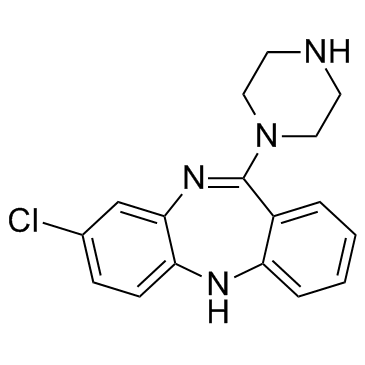| Cas No.: | 6104-71-8 |
| Chemical Name: | Norclozapine; Desmethylclozapine; Normethylclozapine |
| Synonyms: | Norclozapine; Desmethylclozapine; Normethylclozapine |
| SMILES: | ClC1=CC2=C(C=C1)NC3=C(C=CC=C3)C(N4CCNCC4)=N2 |
| Formula: | C17H17ClN4 |
| M.Wt: | 312.8 |
| Sotrage: | 2 years -20°C Powder, 2 weeks 4°C in DMSO, 6 months -80°C in DMSO |
| Description: | N-Desmethylclozapine is a dengue virus inhibitor, and an agonist of δ-opioid receptor. |
| In Vivo: | N-desmethylclozapine in rat and human at M2 and M4 mAChRs underlying presynaptic modulation of GABA and glutamate release, respectively. In particular, N-desmethylclozapine maybe a M2 mAChR antagonist in the rat but has no activity at this receptor in human neocortex. However, N-desmethylclozapine has an agonistic effect at M4 mAChR in the human but no such effect in the rat neocortex[4]. |
| In Vitro: | The IC50s of N-desmethylclozapine, fluoxetine hydrochloride, and salmeterol xinafoate in Huh-7 cells infected with DENV-2 are 1 μM, 0.38 μM, and 0.67 μM, respectively. The levels of NS3 are reduced in cells treated with all three inhibitors compared to DMSO treatment, suggesting that the inhibitors act at a stage prior to viral protein translation. N-Desmethylclozapine-treated cells show a >75% reduction in negative-strand RNA levels[1]. N-desmethylclozapine exhibits slight agonistic effects on the M1 mAChR, and agonistic properties at the 5-HT1A receptor in the cerebral cortex and hippocampus. This compound also behaves as an agonist at the δ-opioid receptor in the cerebral cortex and striatum[2]. N-desmethylclozapine (3 μM) greatly decreases the outward current in excitatory neurons, but not in inhibitory neurons. In excitatory neurons, N-desmethylclozapine alone is more effective than either clozapine alone or the combination of clozapine and N-desmethylclozapine. The effect of N-desmethylclozapine in excitatory neurons is significantly suppressed by 0.1 μM pirenzepine and 1 μM atropine. N-desmethylclozapine, but not clozapine, suppressed K+ channels via M1 receptors in excitatory cells[3]. N-desmethylclozapine leads to a decrease in TxB2 levels under unstimulated conditions as well as under TSST-1 stimulation. Clozapine, N-desmethylclozapine and CPZ possibly act on neurotransmitter systems via modulation of TxA2 or TxB2 production[5]. |

 To enhance service speed and avoid tariff delays, we've opened a US warehouse. All US orders ship directly from our US facility.
To enhance service speed and avoid tariff delays, we've opened a US warehouse. All US orders ship directly from our US facility.




















